Olympic National Park in Washington state is one of the most magical spots on the planet, packing in snow-capped mountains, lush rainforests, and breathtaking beaches- all in one park. With so much beauty, though, it can be hard to narrow down the best hikes in Olympic National Park, with the park offering over 600 miles of trails.
But good news- I’m lucky enough to live within a couple hours of the park and have spent a ton of weekends exploring its amazing trails. So here’s 8 of the best hikes in Olympic National Park, taking you from the top of the Olympic Mountains to the shores of the Pacific Ocean- and providing so many incredible views along the way.
This post may contain affiliate links. If you make a purchase through them, we may receive a small commission, for which we are extremely grateful, at no extra cost to you.

Psssst.. headed to the Olympic Peninsula? Consider me jealous- it’s one of my favorite places on the planet! If you want to make your visit even more epic, check out our other articles about the park:
- 15 Stops Along the Olympic Peninsula Loop
- Tree of Life: Washington’s Most Unique Tree
- 10 Stunning Olympic National Park Beaches
- Weekend Itinerary for Olympic National Park
- Olympic National Park in Winter
Things to know before visiting Olympic National Park
Olympic National Park is tucked into the northwestern corner of Washington state in the Olympic peninsula. To enter the park, you’ll either need to pay a $30 entrance fee per vehicle (good for one week) or present an annual interagency pass, like America the Beautiful.
The park itself is enormous- 1,442 square miles, to be exact!- so in order to get to and around it, you’re going to need a vehicle, whether you’re road-tripping it in your own vehicle or renting a car (unlike some national parks, there’s no shuttle system here).
And while there’s plenty of cute little towns sprinkled throughout the park, the area itself is pretty remote- so download some offline maps on your Google Maps app before heading here, queue up your favorite playlist and get ready for some drive time between trailheads.
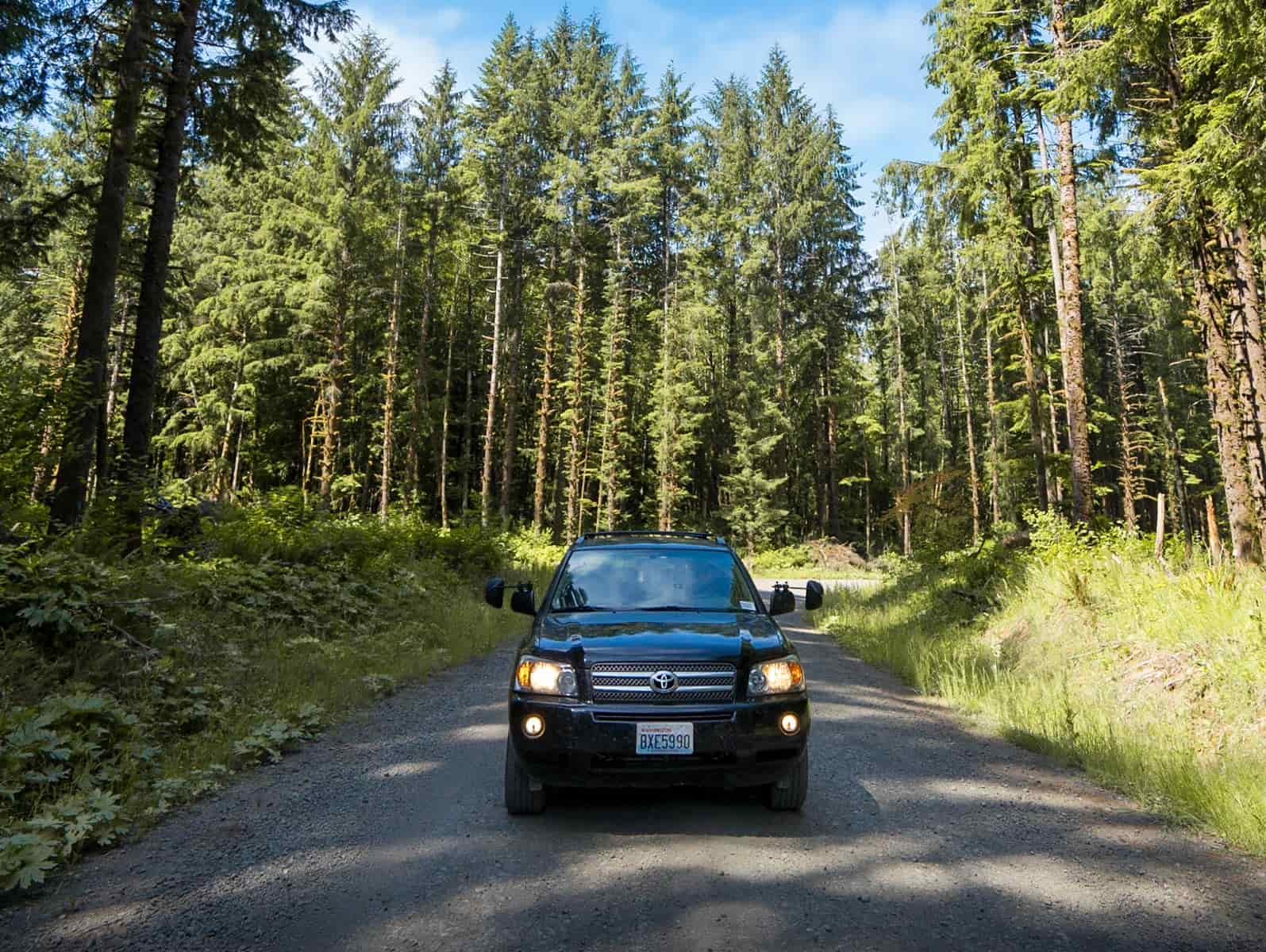
So, besides stocking up on your favorite road trip snacks, what else should you know before visiting the park?
- You know all that driving I mentioned above? Get ready for it to be absolutely spectacular! In fact, did you know that it’s the only national park in the contiguous United States with rainforests? And let’s not forget its gorgeous mountains and beaches strewn with picturesque sea stacks.
So to protect Olympic’s beauty for millennia to come, please be sure to follow the Leave No Trace principles during your visit, like disposing of waste properly (pack it in, pack it out), leave what you find (take only memories, leave only footprints), and respect wildlife (keep a safe distance from bears, deer, and our other woodland creature friends). You know, all those neato things you learned in kindergarten!
TLDR: Learn, love, and follow the Leave No Trace principles.

- Before the area around Olympic was settled by Europeans in the mid-19th century, the land was home to at least 8 American Indian tribes: Hoh, Jamestown S’Klallam, Elwha Klallam, Makah, Port Gamble S’Klallam, Quileute, Quinault and Skokomish.
And like many other national parks, the history of how the park came to be owned by the federal government is problematic, to say the least, with the usual horror stories of settlers spreading novel diseases to the American Indians and the federal government pushing people from their homes into small reservations (see here, here, and here for a few examples of resources).
Nevertheless, many tribes still live on reservations in or adjacent to the park’s borders, including on land by trailheads or along its shorelines. In fact, some super cool hikes in Olympic National Park are on American Indian-owned land and may be subject to additional restrictions, like requiring extra permits (which will be posted in the parking lot or at the trailhead) and even closures.
While none of the trails in this article are subject to these additional restrictions (at the time this article is written, anyway!), please keep an eye out for, respect, and follow any of these additional restrictions.

Best hikes in Olympic National Park
And with all of the logistics/”let’s be decent human” stuff out of the way, let’s talk hikes! Most of the trails listed in this article are appropriate for all levels of hikers and, to the extent they’re on the more on the challenging side, I’ve listed an alternative, more beginner-friendly route to try instead.
Given the spread out nature of the park, I’ll be listing the trailheads’ distance from the town of Port Angeles, Washington, which many visitors use as their homebase during their time exploring the Olympics. Let’s get into it!
1. Hall of Mosses
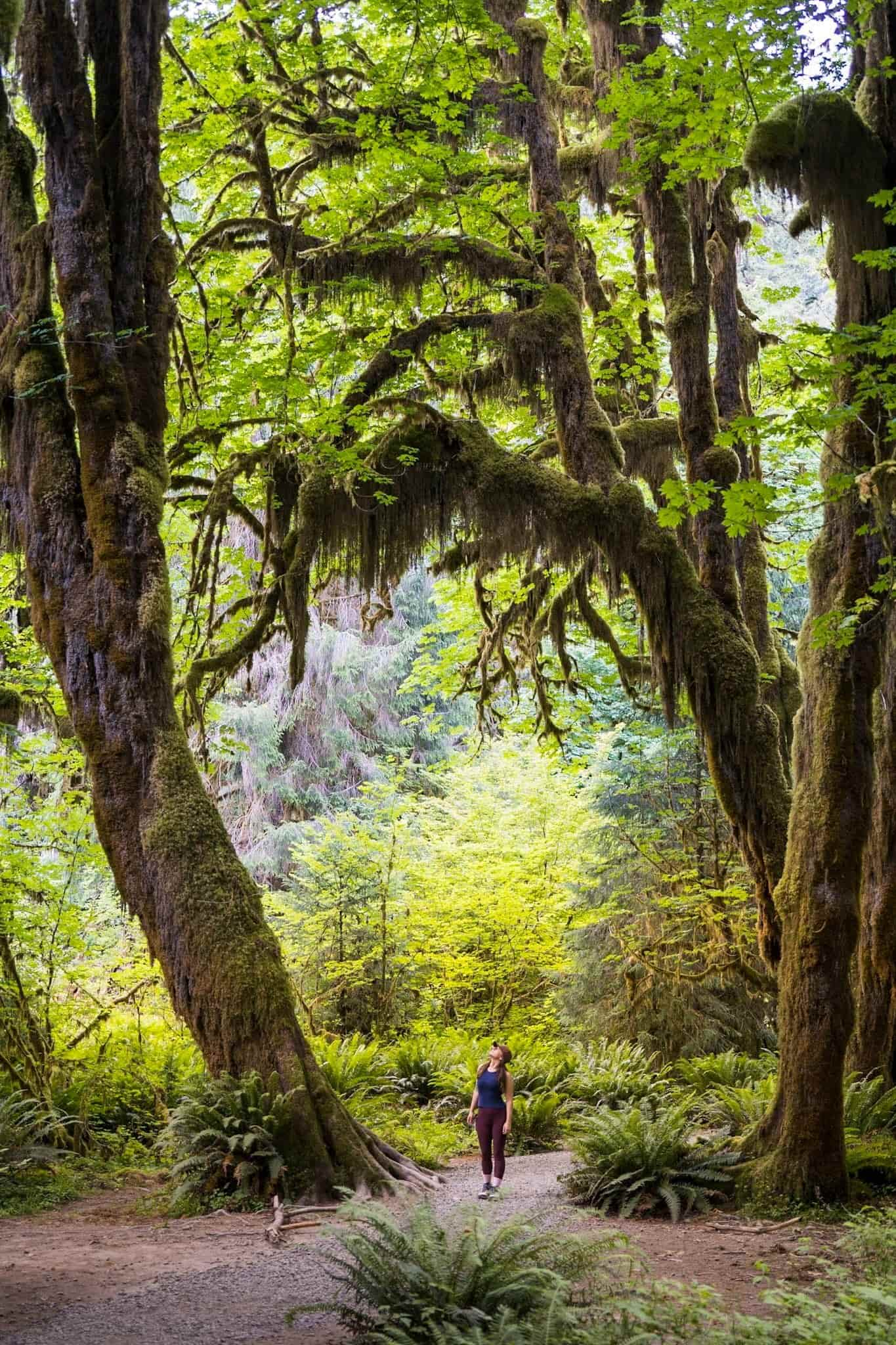
Location: Located here, a little under two hours southwest of Port Angeles
Distance: 1.1 miles
Elevation: 78 feet
Difficulty: Easy
Description: Many national parks have mountains and beaches, but what makes Olympic truly unique, though, is that it’s home to several rainforests, including the Hoh (while American Samoa National Park has tropical rainforests, Olympic is the one and only national park with temperate ones). And the Hoh isn’t any ol’ rainforest- it’s a UNESCO World Heritage Site and a Biosphere Reserve and rumoured to be the shooting location for Endor, home of the ewoks, in Star Wars: Episode VI – Return of the Jedi (is my nerd showing?).
The Hall of Mosses trail takes you through a particularly impressive portion of the Hoh Rainforest, leading you past impossibly tall trees dripping with moss and Jurassic Park-style ferns (seriously, some of the ferns are taller than me!). And if you’re visiting the Pacific Northwest with kids, this is one of the most family-friendly hikes you can go on- beyond the enchanted forest scenery, the trail offers interpretive signs providing interesting information about the forest, its ecology, and wildlife.
So while it’s a little out of the way, the Hall of Mosses feels like something straight out of a fairytale- and one of the most unmissable stops in the park.

Tips:
- Don’t want to drive two hours to hike one mile? Consider adding on two of the other awesome Hoh Rainforest hikes that leave right by the Hall of Mosses’ trailhead.
You can choose from either the Spruce Nature Trail, a 1.4 mile loop trail, that leads through the forest and down along the banks of the Hoh River (keep an eye out for Roosevelt elk here!) or, if you’re REALLY feeling plucky, the 35.3 mile out-and-back Hoh River Trail, both of which leave from the same parking lot as the Hall of Mosses.
2. Hole in the Wall

Location: Located here, one hour and 23 minutes west of Port Angeles
Distance: 3.3 miles
Elevation: 108 feet
Difficulty: Easy to moderate
Description: The path to Hole in the Wall is pretty straightforward- you literally just hike from the parking lot of Rialto Beach, one of the most stunning Olympic National Park beaches, all the way across its pebble-y shores. Along the way, you’ll climb over enormous bleached pieces of driftwood and get amazing views of craggy sea stacks. After about 1.5 miles, you’ll reach a cluster of dramatic sea stacks jutting out of the ocean- and directly past that, a natural arch carved into the stone (yup, the eponymous “Hole in the Wall”).
Once you pass through the archway, you’ll discover that it perfectly frames the neighboring sea stacks- and find some of Olympic’s best tidepools, teeming with sea stars, wolf eels, and anemones.

Tips:
- Plan your visit around low tide- otherwise, the majority of your hike will consist of scrambling over huge driftwood logs and you’ll be unable to access the arch. You can see the tide tables here.
3. Hurricane Hill

Location: Located here, 41 minutes south (and, to be honest, mostly up a mountain) from Port Angeles
Distance: 3.2 miles
Elevation Gain: 650 feet
Difficulty: Easy to moderate
Description: Hurricane Hill is one of the most bang-for-your-buck hikes I’ve done- EVER- and one of the most unmissable stops you need to add to your Olympic National Park itinerary. Once you drive your car up and literally on top of Mount Angeles to the trailhead, the trail will lead you along its ridge, with jaw-dropping views of the Bailey Range of the Olympic Mountains in every direction that will have you singing the Sound of Music soundtrack.
Along the path, you’ll have opportunities to see technicolor wildflowers (if you’re visiting in the summer); abundant furry friends, like mountain goats or blacktail deer; and, on a clear day, views all the way to the beautiful Vancouver Island, Canada.
The beginning of the trail is flat, with a gentle uphill climb starting about half a mile into your hike; about one mile in, you’ll start the four fairly steep switchbacks up to the top of Hurricane Hill itself. If the final climb up is too strenuous, not to worry- this hike is truly one of those examples where it’s all about the journey, not the destination.

Tips:
- Hurricane Hill is one of Olympic’s most popular hikes (for good reason), but the parking lot is kind of absurdly tiny (holding about 40 cars). And while there’s an overflow lot nearby, parking there will add 0.5 miles to your total hike- and it’s pretty small as well. So be sure to get here fairly early (8 AM or earlier) to be sure you snag a spot!
- In case you missed it, the trail is so spectacular because it’s literally on top of a mountain. And perhaps it comes as no surprise but mountaintops can get LOTS of snow, come winter. In fact, from mid-December through March, the steep and windy road to Hurricane Hill is only open on weekends and Monday holidays (9:00 am to 4:00 pm, weather permitting) and all cars are required to carry tire chains.
So if you visit in that timeframe, be sure to check the Olympic National Park website before you head there to confirm the road is open, bring some snowshoes (my husband has this pair and I have these), and get your snow game face on.
4. Ozette Loop

Location: Located here, a little under two hours west of Port Angeles
Distance: 9.4 miles
Elevation: 538 feet
Difficulty: Moderate
Description: The Ozette Loop (also called the Ozette Triangle Trail) is quite a unique hike. From the parking lot near the Ozette Ranger Station, you can take either leg of the equilateral triangle that forms the trail (I knew my fourth grade geometry would come in handy one day!)- heading south is the North Sand Point Trail and to the north is the Cape Alava Trail). No matter which route you choose, you’ll follow a raised wooden boardwalk that snakes through a mossy old-growth forest of cedars and hemlock.
After a little over three miles of hiking under a cathedral of grand trees, the trail will spit you out on the Pacific coastline, where you’ll have endless views of rugged pine tree-topped sea stacks. Here, you’ll walk 3.3 miles across the beach (from Sand Point to Cape Alava, the westernmost part of the contiguous United States, or vice versa), and along the way, climb over enormous pieces of driftwood, scale around rocky outcroppings, and weave your way past countless tidepools, filled with marine flora and fauna.
You also have a good chance of seeing wildlife along the beach- for example, we saw a ton of deer and a bald eagle. Essentially, the trail kind of feel like the world’s most hands-on nature discovery trail- even as a grown woman, I felt like a giddy little kid, getting up close and personal with the beautiful coastline.
When you’re ready to say adieu to the Pacific, you’ll follow the other leg of the triangle back to the parking lot, getting one more chance to experience the beauty of Washington’s forests.

Tips:
- The only thing challenging about this hike is its length. If nine miles is too much for you, consider hiking this trail as an out-and-back hike, either along the North Sand Point Trail or the Cape Alava Trail (which will be approximately 5.8 miles). Alternatively, there’s several other beaches along Olympic’s coastline that require a short and easy hike through coastal forests, like Second or Third Beach.
- It’s much easier (and more fun!) to do this trail at low tide, where you’ll have a wide swath of the beach and intertidal area to explore. Come high tide, the beach portion of your hike will mostly consist of scrambling over driftwood- so try to time your hike accordingly (check tide charts here).
- Sometimes, the beach portion of the trail can get flooded in particularly rainy weather (which, in Washington, kind of happens a lot). So make sure to check the status of the trail here prior to making the drive out.
- Once you’re on the beach portion of the trail, it can be challenging to find the re-entry point to start making your way back to the car, given how thick and wild the forest is. I mentioned this above, but I’d highly recommend either downloading offline maps on the Google Maps app or the trail on the All Trails app to make sure you can stay on the trail.
Pssst… you need the AllTrails+ version of the app to download offline maps, but luckily, our awesome readers can get a 7-day free trial PLUS 30% off your first year by using this link and the promo code "UPROOTED30" at check out. If you're wondering whether the app is for you, we wrote a whole post on whether AllTrails+ is worth it.
5. Lovers Lane

Location: Since it’s a loop, you can either start here, by the Sol Duc trailhead or here, by the Sol Duc Hot Springs Resort (I’d suggest starting at the Sol Duc Hot Springs Resort so the waterfall along the trail is saved more towards the end), about one hour southwest of Port Angeles.
Distance: 6.1 miles
Elevation: 590 feet
Difficulty: Moderate
Description: Rainforests, waterfalls, hot springs- this hike has it all! Along the south end of the loop, you’ll pass through yet another stunning rainforest straight out of Middle Earth, with towering sitka spruces (the tallest spruce species on the planet!) and abundant cartoonish mushrooms.
The trail is full of all kinds of fun features, like a single log tree carved into a footbridge you need to scale to cross a babbling brook and a wooden boardwalk skimming the surface of a mysterious-looking marsh. And if a forest that looks like Hobbits inhabit it isn’t enough for you, the trail offers not one- but TWO- waterfalls, the 53-foot Lover’s Lane and the 50-foot Sol Duc Falls, renowned as the most beautiful in the park. Unlike most waterfalls in Olympic, you’ll gaze at the latter above the brink as its three-prongs cascade into a slot canyon below.

Tips:
- Much like the Ozette Triangle, the only thing particularly challenging about this hike is the length (and the occasional downed tree you may need to scramble over). So if you’re looking for something a bit shorter, consider hiking the 1.6 mile Sol Doc Falls trail, which provides a flat, wide trail to see the beautiful falls.
- The north leg of the loop is not quite as stunning as the southern portion- along the northern route, you’ll mostly follow along Sol Duc Road, pass through several campgrounds, and scratch your head at poorly marked trail signs. For maximum Hobbitness, I’d recommend instead doing this trail as an out-and-back hike along the loop’s southern route.
- Did someone say hot springs? While the trail doesn’t have any natural hot springs, there are commercialized springs right by one of the trailheads at the Sol Doc Hot Springs Resort.
Here, you can enjoy three pools with geothermally-warmed waters and one filled with freshwater to cool off during hot summer days (note that the resort is only open from the end of May through the end of September). You can either purchase a day pass (for non-guests, it’s $15 for adult passes; $3 for towel rentals; and lockers are free!) or if you’re looking for a place to stay during your time in Olympic, there’s cozy cute cabins, nestled in this beautiful forest.
6. Mount Storm King
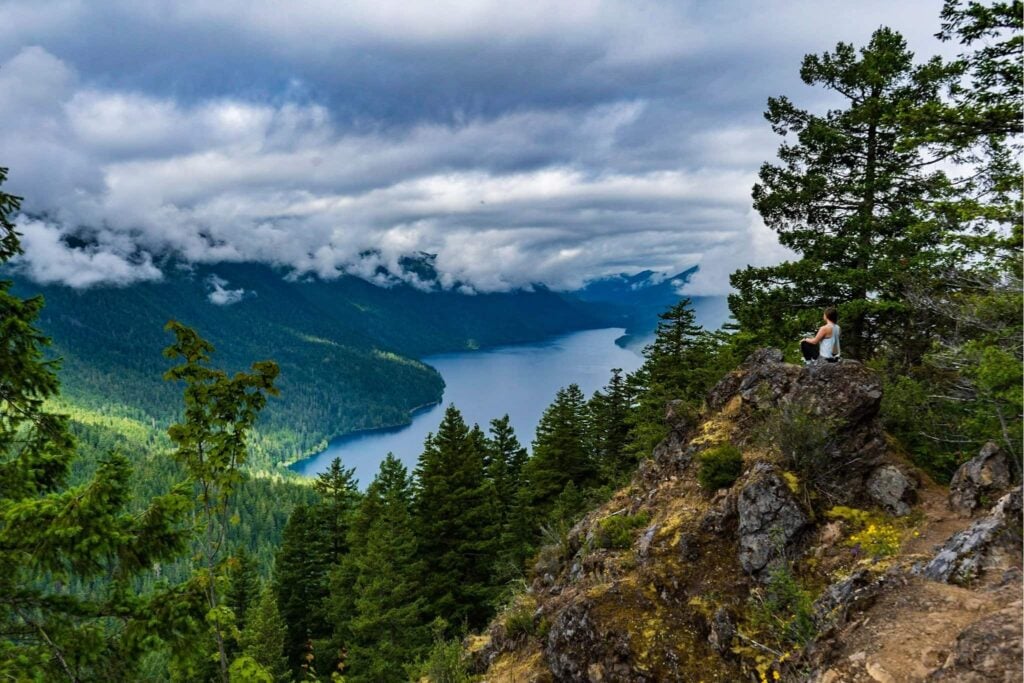
Location: Located here, 25 minutes east of Port Angeles
Distance: 5.2 miles
Elevation: 2,076 feet
Difficulty: Challenging
Description: Mount Storm King is both technically and physically challenging, but the ultimate payoff is worth it. You’ll start along a deceivingly flat path through a forest of enormous cedar trees. About half a mile in, there will be a haphazard sign leaning against a boulder on the left, pointing up towards Storm King. Following that sign, you’ll climb a series of seriously steep switchbacks for the next 1.7 miles, slowly earning peeks of the brilliant blue waters of Lake Crescent and the emerald hills surrounding it below, and eventually reaching the rocky spine of Storm King.
About 0.4 miles from the actual summit, the portion of the trail maintained by the National Park Service will end (clearly demarcated by a sign). After this point, you’ll reach the top of Mount Storm King by pulling yourself up several ropes tied by other hikers to sketchy-looking trees and finally scrambling along a steep rock wall (with even steeper drop-offs) to the summit.
Here, you’ll be rewarded with panoramic views of the lake and the lush forests surrounding it. This portion of the hike is, in my opinion, quite technically challenging; not to be a Debbie Downer, but one misstep (or broken rope from the aforementioned sketchy trees) and you could very well be seriously injured- or die. As such, you should be confident in your skill level to attempt this, don’t go up anywhere that you’re unsure of getting down, never pressure anyone to continue if they feel unsafe, and proceed at your own risk.

Tips:
- If you’re planning on doing the unmaintained portion of the trail, I’d recommend bringing along some climbing gloves to protect your hands, in case you lose your footing trying to climb up the ropes on the steep and slippery hills to the summit.
- Not quite up to literally scaling a mountain? A good alternative (or addition!) to this hike is the 1.8 mile out-and-back, family friendly hike to Marymere Falls, which follows along the same trail as the beginning portion of Mount Storm King and leads to a 200 foot-waterfall, cascading down a mossy cliff.
7. Enchanted Valley Trail
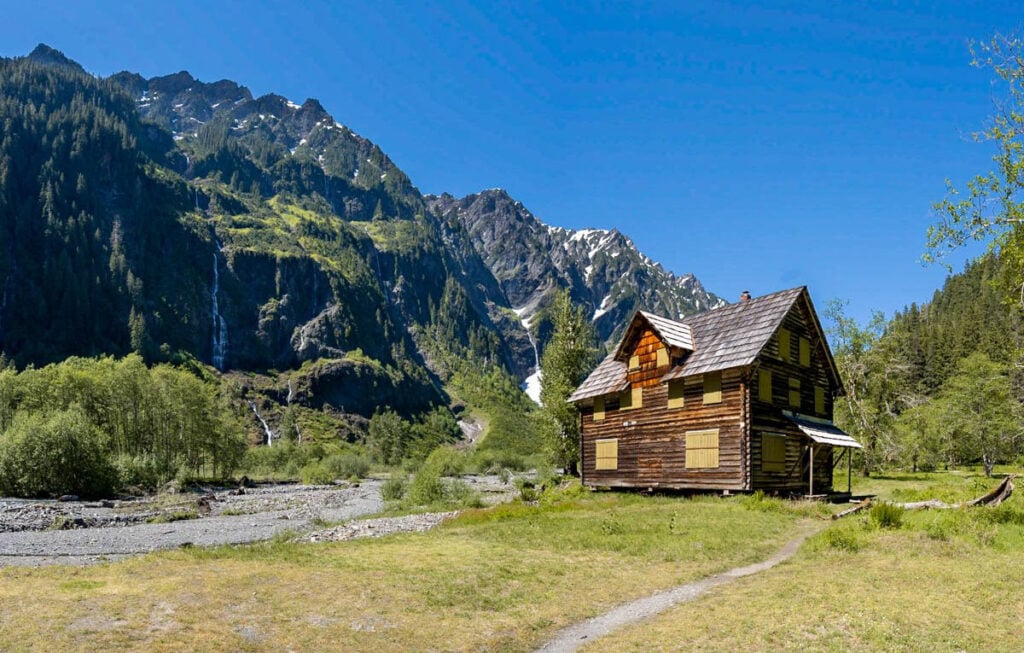
Location: Located here, 139 miles from Port Angeles
Distance: 29ish miles
Elevation Gain: 3,244 feet
Difficulty: Challenging. The trail does not have any intense elevation or any technical challenges, but the trail is loooong!
Description: If you’re looking for a multi-day epic adventure in Olympic National Park, the Enchanted Valley trail should absolutely be at the top of your list. Tucked away along the southern portion of the Olympic Peninsula Loop in the seriously underrated Quinault Rainforest, this trail will take you along the Quinault River, through a luscious rainforest, and ultimately lead you to the Enchanted Valley.
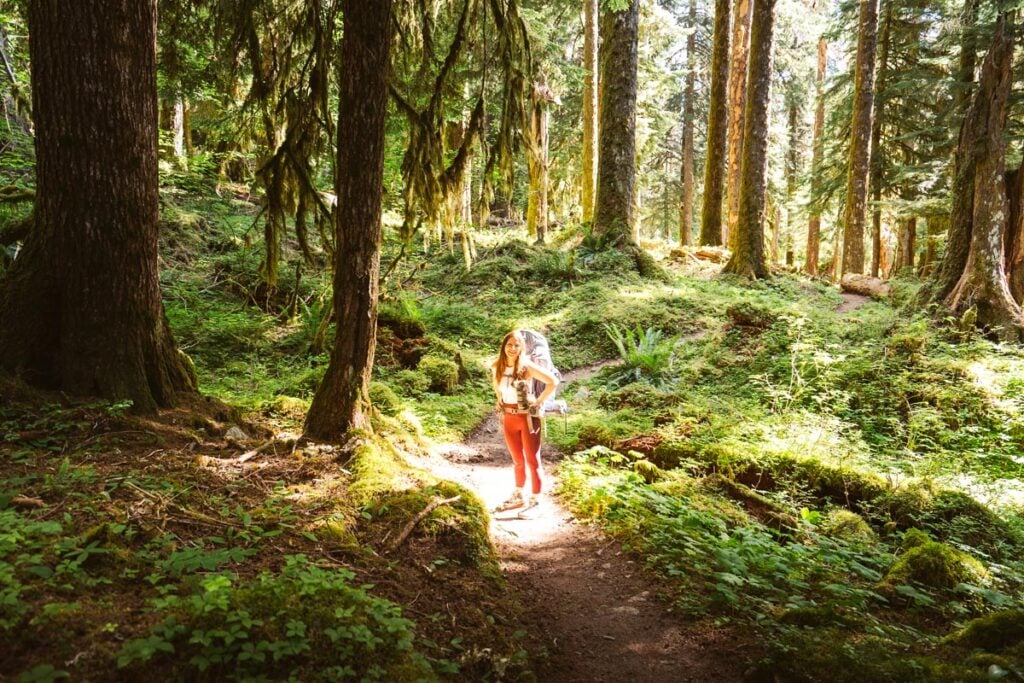
The Enchanted Valley is nothing short of breathtaking- an expansive meadow is bordered on one side by a dense forest of western hemlocks and cedar trees and on the other, a wall of seemingly vertical mountains, covered with cascading waterfalls.
If that isn’t picturesque enough for you, there’s also a historic cabin (aptly named “the Enchanted Valley chalet”), built in 1931, that cheerily sits in the shadows of the towering mountains. The Enchanted Valley chalet once served as a spot where tired hikers could rest and get a warm meal. While you can no longer go inside the chalet, it’s become something of an iconic landmark along the trail.

Tips:
- Unless you plan on doing this as a day hike (in which case, hats off to you!), you’ll need a permit to camp along the trail. You can pick up a permit here, choose “Quinault” as your starting point, and select the dates you’d like to stay along the Enchanted Valley trail.
Note that there are 3 primitive campgrounds along the trail, as well as the Enchanted Valley itself, where you can plan to camp:- Pony Bridge (2.5 miles into the trail)
- O’Neil Creek (6.4 miles into the trail)
- Pyrites Creek (9 miles into the trail)
- The Enchanted Valley is known for being an excellent place to spot deer, elk, and black bears. Accordingly, you are required to have a bear cannister to camp here- you can either rent one at the Quinault South Shore Ranger Station or pick one up here.
To be honest, there’s kind of a lot to know about planning a backpacking trip here, so we wrote an entire guide about how to hike the Enchanted Valley trail!
8. Shi Shi Beach

Location: Located here, 77 miles west of Port Angeles
Distance: 8.8 miles
Elevation gain: 561 feet
Difficulty: Moderate
Description: Shi Shi Beach is one of the most dramatic beaches along the coastline, with a stunning cluster of sea stacks known as the “Point of Arches”. To get to the beach itself, you need to hike two miles through marshy rainforest using wooden boardwalks and bridges and, eventually, an extremely muddy trail.
You’ll eventually take a series of steep switchbacks down onto the shoreline, where you’ll be greeted with panoramic views of a sandy beach, lined with towering pine trees, and off in the distance, the Point of Arches jutting out of the Pacific.
To get a closer look at the sea stacks, you can continue walking two more miles down the coastline, as Pacific wren and seagulls soar overhead.

Tips:
- The Shi Shi Beach trailhead is located on the Makah Reservation in the northwesternmost tip of Washington state, whereas the beach itself is within Olympic’s borders.
The Makah tribe has graciously allowed hikers to access the beach using the trailhead, so long as they purchase a Makah Recreation Pass at a variety of businesses in the neighboring town of Neah Bay, providing access to Shi Shi and some of the other incredible recreation sites on the Makah’s land, like the Cape Flattery Trail.
If you plan on camping at Shi Shi Beach, you’ll also need to pick up a wilderness permit for Olympic National Park from Recreation.gov. While getting to Shi Shi may take a bit of legwork, waking up with the Point of Arches as your backyard for the day will 100% be worth it. - As mentioned above, the trail to Shi Shi is notoriously muddy. Wear sturdy hiking boots (I have this pair and Justin has these), so you don’t run into an Indiana-Jones-in-quicksand situation along the trail.

When to visit Olympic National Park
The best time to visit Olympic National Park is in the summer (June through October), when the temperature is pleasant, you’ve got a better chance of clear skies, and vibrant wildflowers carpet its meadows and valleys. One of the awesome things about Olympic, though, is that it’s wonderful to visit year round.
In the wintertime, the park looks just a little extra magical with a light dusting of snow (although note that, if you visit during the colder months, many higher elevation hikes will be inaccessible due to a whole lotta snow) and the rainy fall and spring bring out the mysterious and moody beauty of the Pacific Northwest. Just make sure to bring along the proper gear, depending on your visit, which brings me to…

What to pack for Olympic National Park
Most of these hikes aren’t super challenging so you fortunately don’t need too much technical gear. But there are a few things you should consider bringing to make your trip as epic as possible:
- Rainjacket: Fun fact- parts of Olympic National Park are the wettest areas in the contiguous United States. Even on sunny days, it’s not uncommon for a sprinkle to come out of seemingly nowhere, so come prepared- bring along a rainjacket (like this one for men or this one for women).
- Water-resistant, quick-dry hiking pants: Did I mention that it can rain A LOT here? And what could possibly be worse than hiking in a pair of wet jeans (two words: chub. rub.)? Bring along some quick-dry hiking pants to avoid the dreaded chaffing nightmare, like these for women and these for men.
- Bear spray: Unlike some other U.S. National Parks, there are no grizzly bears in Olympic, but there are definitely black bears. They are usually scared of humans and it’s fairly unlikely they’ll harm you, although mother black bears have been known to be aggressively protective around their young. Because of this risk (and some other critters like cougars and even mountain goats, who can be weirdly aggressive!), I take bear spray (which is used much like pepper spray to temporarily disorient, but not injure aggressive animals) with me wherever I go hiking in Washington state. Although we thankfully have never had to use it, we have this one.
Note that you cannot take bear spray on airplanes, so if you’re flying in to visit the park, I suggest picking one up at a local REI.

Where to stay in Olympic National Park
As mentioned above, the best home base for exploring most of Olympic’s most beautiful and popular attractions is Port Angeles. Consider:
- Olympic Lodge: About as bougie as this port town gets, with reasonable rates, spectacular mountain and ocean views, and a pool!
- Emerald Inn: Quaint and cozy lodge right by the gorgeous Lake Crescent, with comfy beds, a view of the mountains, and a gaggle of cute farm animals running about.
Alternatively, the tiny town of Forks, Washington on the west side of the park can be another great option, given its proximity to the Hoh Rainforest and the coast (plus its fame for teen sparkly vampire romances is nothing to sneeze at). Check out:
- The Woodland Inns: Cozy private cabins with a communal fire pit to maximize the summer camp vibes
- Pacific Inn Motel: Locally owned motel in Forks, within walking distance to the town’s small downtown area. Plus, there’s an entire Twilight-themed room, if that’s your thing!
- Hoh Valley Cabins: If you like staying somewhere that feels a bit more homey, each of these bungalows come with kitchenette, a wide deck, and barbecue grills.
I hope you have an amazing time exploring Olympic’s trails and soaking up all of its moody PNW vibes. Do you have other favorite trails in the park? Let me know in the comments section below!
Thank you for reading our post! Check out our latest stories here and follow us on Instagram (@UprootedTraveler), YouTube, or on Facebook to see what we’re up to next!


